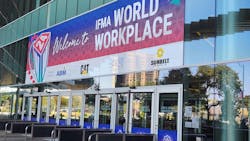4 Emergency Response Scenarios You Can Prepare For, Starting Today (IFMA 2024)
Emergencies can happen when you least expect them—and when they occur, it pays to be prepared. Solution providers at the 2024 IFMA World Workplace Conference & Expo shared their tips for tackling four potentially catastrophic emergency scenarios.
1. Elevator Entrapments
Elevator breakdowns can mean people are trapped inside the cab—and if that’s the case in your facility, the entrapment victims need a way to communicate so you can help them get out. Unfortunately, the standard communication method—Plain Old Telephone Service, or POTS—was deregulated by the FCC, so telecom providers are no longer required to maintain the copper lines and analog phone services that are probably still in your elevators. In addition, the 2019 update to ASME A17.1 requires a video feed and text messaging capability for elevator communications to assist people who are hearing and/or speech impaired and can’t use emergency phones.
At World Workplace, Kings III Emergency Communications showcased two solutions for upgrading elevator phones and replacing old POTS lines. Both use a 4G LTE cellular connection to receive calls from elevator emergency phones and patch them through to Kings III’s dispatch personnel. One is a turnkey package where Kings III manufactures, installs, monitors, and services your POTS replacement. The other is a plug-and-play device that only needs access to a power outlet and an adequate cellular signal.
“The POTS telephone industry and the elevator industry are both going through extreme, historic changes,” said James Bowers, solutions engineering manager for Kings III Emergency Communications. “Kings III has put all of our efforts into making sure we’re ready to provide the correct type of service and keep you up to code, compliant, and free of risk of liability.”
2. Evacuating People with Disabilities
From simple fires to terrorist events, there are many reasons why you might have to evacuate people from your facility quickly—and when that day comes, you can’t leave anyone behind. The Evac Chair helps people with disabilities get down to the ground floor quickly and safely, even if your elevators aren’t working. The company’s evacuation chairs were even used to get people out of the World Trade Center on 9/11 and are now featured at the 9/11 Memorial & Museum.
Evac Chair offers 10 wall-mounted, foldable models, from a manual chair that uses friction to evacuate people down the stairs to a battery-operated model with a weight capacity of up to 560 pounds. The company also has a sling attachment for some of the models that allows users to evacuate infants from hospitals and care units safely.
“There are so many things that can happen when an emergency occurs and an elevator stops working,” said Steve Agisnaga, Evac Chair’s vice president of global operations for North America. “Facility owners and managers need to have something in place to be proactive and save lives.”
3. Cardiac Arrest
Does your facility have an automated external defibrillator (AED)? Does everyone know where it is? At World Workplace, ZOLL Medical showcased AEDs that take bystander assistance a step further with real-time CPR feedback. “When you’re doing compressions on someone with cardiac arrest, our AEDs are going to walk you through it—what to do, how to do it, and correct you if you’re doing it wrong,” explained Sina Samali, global product manager for ZOLL Medical’s G5 and Mobilize products.
The units are designed for use by people with no medical background and are ideal for any facility or public place where a large number of people congregate. They can be placed anywhere in your building, but ideally, someone should be able to retrieve the AED within three minutes of witnessing a cardiac event.
“Act now,” Samali urged. “Don’t wait until something happens for you to purchase an AED. Be prepared beforehand.”
4. Water Damage
Water can do an incredible amount of damage in a short time. Are you ready to act if a pipe bursts or your ground floor floods? Ready 2 Respond—a restoration program by Legend Brands—is aimed at empowering facility teams to respond to water damage right after it happens, which can save time and money and limit downtime.
“What you do in the first 100 minutes determines the next 100 hours,” said Michael Redd, MRO sales manager for Legend Brands. “You can help mitigate some of that initial water damage even before the contractor arrives, and that can be helpful in the scale of loss.”
R2R’s seven-step process starts with an on-site assessment. Your facility will be inspected, and R2R professionals will help you determine where the gaps are in your response to water damage and loss, explained Rachel Paff, Ready 2 Respond strategic communications manager and public relations. You’ll learn how different pieces of equipment can assist your response, and your staff will be trained on how to conduct initial restoration steps.
“We’re talking about a shift in culture and leadership—not asking people to add to their very full plates, which all facility managers have, but understanding they can respond and respond well,” Paff said. “It’s a powerful thing to see.”
About the Author
Janelle Penny
Editor-in-Chief at BUILDINGS
Janelle Penny has been with BUILDINGS since 2010. She is a two-time FOLIO: Eddie award winner who aims to deliver practical, actionable content for building owners and facilities professionals.

